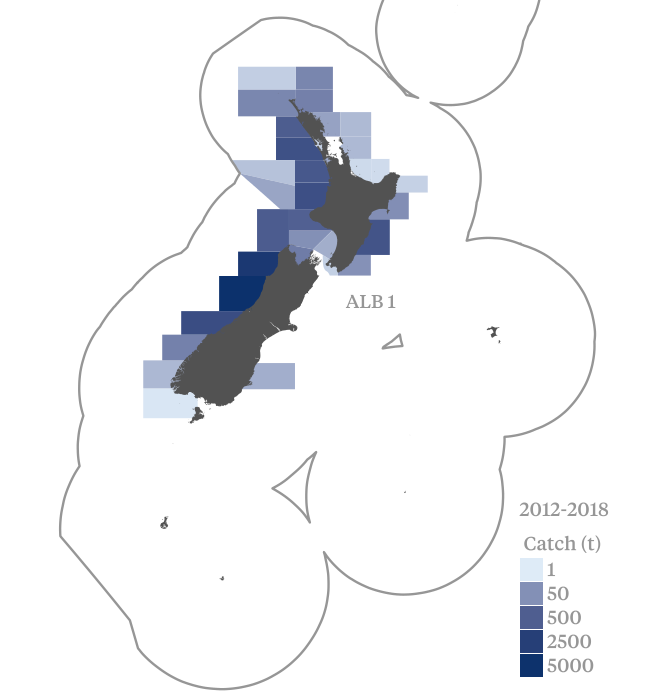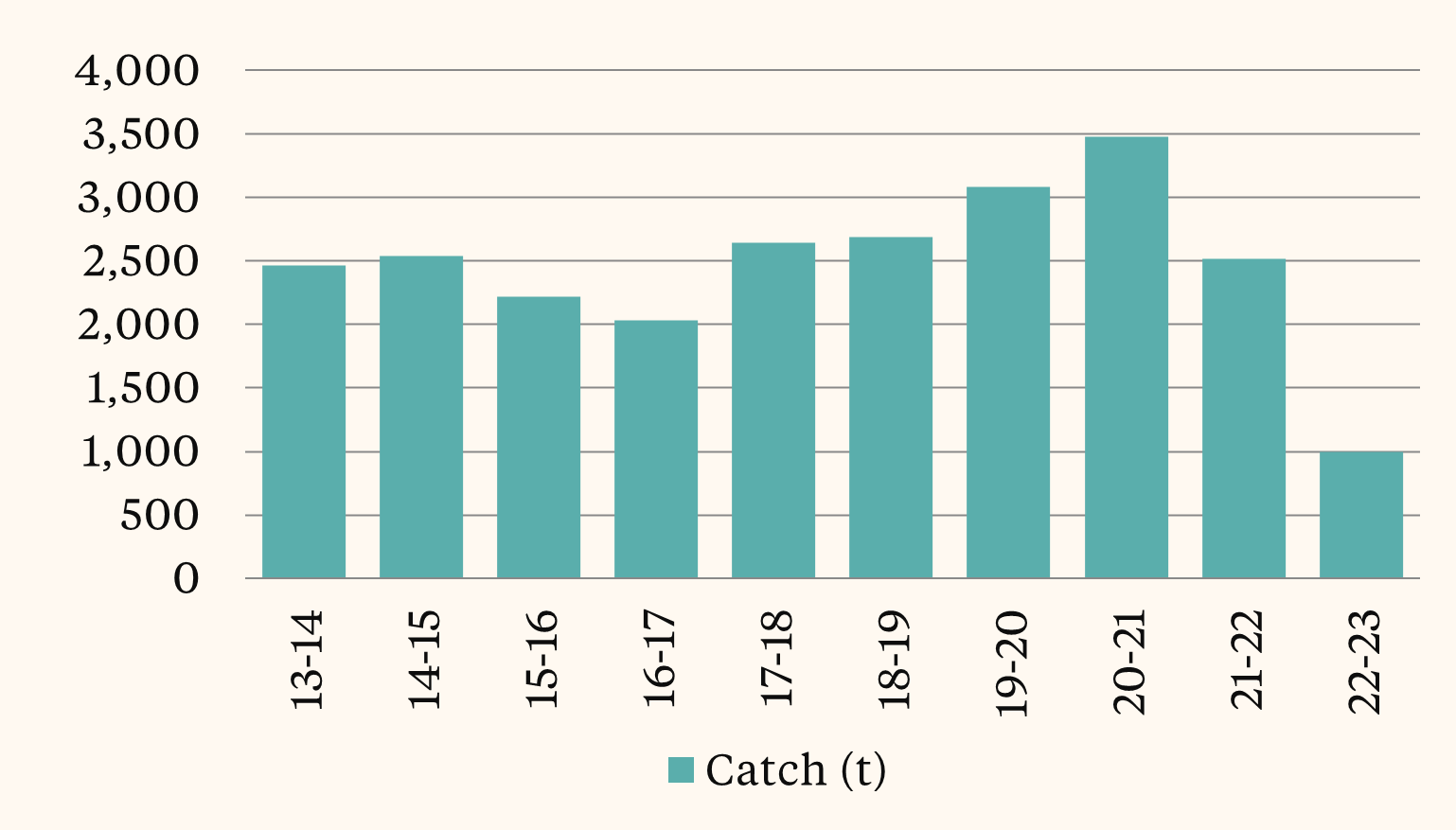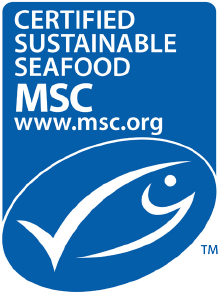Long finned Albacore, Tunny
The New Zealand albacore tuna troll fishery is a well managed and sustainable fishery in accordance with the Marine Stewardship Council's Principles and Criteria for Sustainable Fishing.
In the Pacific Ocean, there are two managed populations of albacore tuna, North Pacific and South Pacific. Management of the South Pacific albacore tuna stock is the responsibility of the Western and Central Pacific Fisheries Commission (WCPFC). The South Pacific albacore catch peaked in 2017 (92,989 t). Catches from within New Zealand waters in 2017 were about 2% of the South Pacific albacore catch, ranging between 2,118 t and 3,503 t over the last 10 years. The New Zealand albacore fishery, especially the troll fishery, has been characterised by periodic poor years that have been linked to poor weather or colder than average summer seasons.
Albacore form the basis of a summer troll fishery in New Zealand, primarily on the west coasts of the North and South Islands. The commercial albacore troll fishery operates between December and May each year. The fish are also caught throughout the year as bycatch on sets targeting bigeye and southern Bluefin tuna.
Vessels in the fishery are typically 12-24 m in length, operating with crews of 2-5, with a holding capacity of 3 to 20 t (held on ice). Being seasonal, albacore fishing usually forms only one of several fishing activities for the vessels involved.
Albacore tuna are considered as a highly migratory species. As such the key components of the governance and fisheries management relevant to this troll fishery include both the WCPFC and the New Zealand Government.
The MSC certificate covers all New Zealand vessels permitted by Fisheries New Zealand to fish for albacore in the NZ fisheries waters using troll gear. Roughly 90% of albacore tuna caught in New Zealand is caught using this method. Albacore was first certified in 2011 and re-certified in 2017.
For more information, download the full MSC Certification Report.
The MSC scheme follows international benchmarks to promote robust processes and uphold values of independence, transparency, impartiality, and stakeholder consultation.
The MSC assessment process is run by an independent certification body (accredited by Accreditation Services International GmbH). A group of auditors (with expertise in the fishery and ecosystems under consideration) are responsible for scoring the performance of the fishery based on scientific evidence. Auditors must meet the qualifications and competencies set out in the MSC Certification Requirements.
In order to achieve MSC certification, a fishery must pass 28 performance indicators within three core principles: sustainable stocks, minimising environmental impact, and effective management.
The certification process takes between 6 and 18 months. The assessment process includes opportunities for stakeholder input and peer review. Certification lasts up to 5 years, during which time the fishery makes any improvements required as a condition of certification. Annual audits are carried out by the certifier to ensure continued compliance. A full reassessment of the fishery must be completed within five years of the last certificate being granted.
The information presented on this page is extracted from the MSC Public Certification Report and most recent Surveillance Audit Report. More information can be found at www.msc.org


Assessment Summary

Sustainable target fish stocks
Principle 1 states a fishery must be conducted in a manner that does not lead to over-fishing or depletion of the exploited populations and, for those populations that are depleted, the fishery must be conducted in a manner that demonstrably leads to their recovery.
The most recent assessment determined that overfishing is not occurring and the stock is not in an overfished state. The latest estimates of spawning biomass (2018) are above both the level that will support the maximum sustainable yield. There are currently no agreed biomass-related target reference points for any species, but the WCPFC is discussing economic-based target reference points for the South Pacific albacore tuna stock.
The harvest strategy for WCPO albacore has several components, with WCPFC, national, and archipelagic management actions, supported by a robust stock assessment and extensive monitoring frameworks. Systems are in place for recording catch and effort for all fishing entities fishing for South Pacific albacore. Although the WCPFC has established a process for the adoption of harvest control rules, well-defined harvest control rules are not currently in place and no formal review process exists. In 2018, an interim target reference point (TRP) of 56% SBF=0 was adopted by WCPFC with the objective of achieving an 8% increase in CPUE for the fishery.
Environmental impact of fishing
Principle 2 states that fishing operations should allow for the maintenance of the structure, productivity, function, and diversity of the ecosystem (including habitat and associated dependent and ecologically related species) on which the fishery depends.
No impacts on primary, secondary, endangered, threatened, or protected (ETP) species or habitats were identified.
Catches other than albacore tuna are very low (< 1% of the total).
Available data indicates interaction with ETP species is negligible and information is adequate to support current approaches. A qualitative risk assessment of potential interactions of seabirds with commercial fisheries suggested a moderate risk for black petrels. However, studies concluded that interactions were possible but uncommon.
The troll fishery operates entirely at the surface in open ocean waters and the gear does not contact the seabed nor impact on any pelagic habitat.
Effective management
Principle 3 requires that a fishery is subject to an effective management system that respects local, national, and international laws and standards and incorporates institutional and operational frameworks that require the use of the resource to be responsible and sustainable.
The Convention for the Conservation and Management of Highly Migratory Fish Stocks in the Western and Central Pacific Ocean established the WCPFC in 2004 to conserve and manage migratory fishery resources in the WCPO. The Convention provides a framework for the participation of fishing entities in the Commission which legally binds fishing entities to the provisions of the Convention, participation by territories, and possessions in the work of the Commission. New Zealand is one of 27 members, of which most are small island developing states.
As a member of the WCPFC, New Zealand is responsible for ensuring management measures applied within New Zealand fisheries waters are compatible with those of the WCPFC, and fishing by New Zealand flagged vessels both within and beyond the New Zealand EEZ is carried out in accordance with any measures put in place by WCPFC.
Albacore tuna are not managed under the New Zealand Quota Management System. However, the other elements of the Fisheries Act 1996 apply. The Act provides the legislative framework for fisheries management, within New Zealand fisheries waters and for New Zealand flagged vessels and nationals on the high seas. The purpose of the Fisheries Act 1996 is to provide for utilisation of fisheries resources while ensuring sustainability. In giving effect to the purpose of the Act, decision-makers are required to take into account environmental and information principles, and to act consistently with the Treaty of Waitangi (Fisheries Claims) Settlement Act 1992 and international obligations.
The Management Plan for the albacore tuna troll fishery is part of the National Fisheries Plan for Highly Migratory Species. This Plan was signed off by the Minister of Fisheries in 2010. The Plan is implemented by an Operational Management Plan and a series of Annual Operational Plans that specify key areas of focus year to year. Performance against the Plans is reviewed in a series of Annual Review Reports.
The MSC assessment determined there are strong fisheries management and research systems operating in New Zealand. However, the large number of small vessels complicates monitoring and there is a low level of observer coverage.
Summary of assessment conditions
Two criteria that contribute to the overall assessment score scored less than the unconditional pass mark, and therefore trigger a binding condition to be placed on the fishery, which must be addressed in a specified timeframe. Two conditions of certification were proposed, both for Principle 1 (1.2.1 in one part and 1.2.2 in three parts). An additional condition was added following the first surveillance audit. Conditions are:
- Harvest strategy standard: By the fourth surveillance audit, demonstrate that the harvest strategy for albacore tuna is responsive to the state of the stock, and the elements of the harvest strategy work together towards achieving stock management objectives reflected in PI 1.1.1 SG80.
- Harvest control rules (a): By the fourth surveillance audit, demonstrate that well-defined harvest control rules are in place that ensures that the exploitation rate is reduced as the point of recruitment impairment is approached, are expected to keep the stock fluctuating around a target level consistent with (or above) maximum sustainable yield.
- Harvest control rule (b): By the fourth surveillance audit, provide evidence that the harvest control rules are likely to be robust to the main uncertainties.
- Harvest control rules (c): By the fourth surveillance audit, demonstrate that available evidence indicates that the tools in use are appropriate and effective in achieving the exploitation levels required under the harvest control rules.
- By the fourth surveillance audit (considering the updated South Pacific albacore stock assessment due in 2018 and consequent management advice) demonstrate that WCPFC decision-making processes have responded to the albacore catch rate issue by putting in place an appropriate harvest strategy or other suitable management measures

